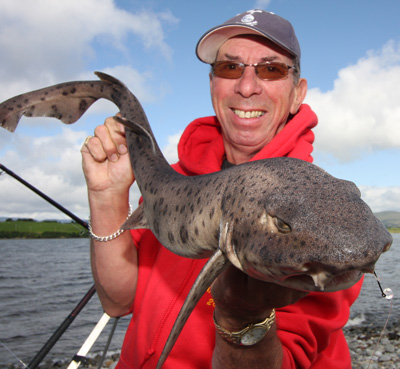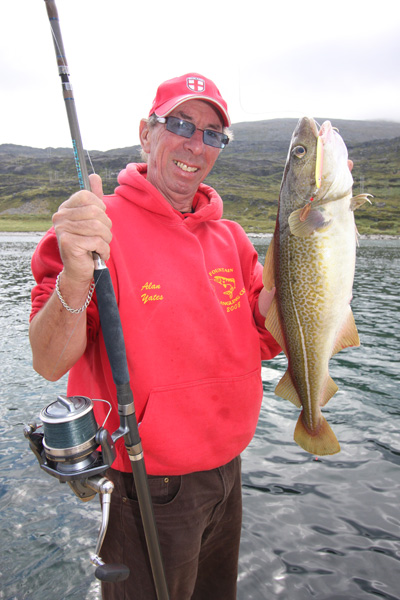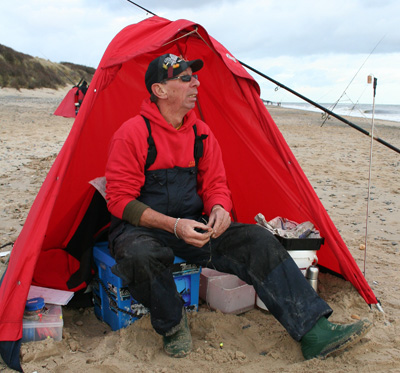Whilst the last month or so has been slow for me personally, around many parts of the UK coast the smoothhound, rays, bass and even tope have appeared in enough numbers, and of a big enough size, to keep many sea anglers enthusiastic all summer. Now it’s autumn, which in the past was always the time to go sea angling, and we all wait with baited hooks to see what this exciting season will bring.
 History tells us that autumn is a time of plenty as the summer and winter fish species migrate and overlap. It’s possible to catch bass and cod at the same time whilst mackerel, scad, pollack and others linger in some regions along with the biggest mullet. Already showing are whiting and dabs and they will stay on as the summer fish migrate to deeper water.
History tells us that autumn is a time of plenty as the summer and winter fish species migrate and overlap. It’s possible to catch bass and cod at the same time whilst mackerel, scad, pollack and others linger in some regions along with the biggest mullet. Already showing are whiting and dabs and they will stay on as the summer fish migrate to deeper water.
Of course autumn is all about cod to a majority of sea anglers and it’s their demise that hurts the most. So it’s pleasing to be able to report with some enthusiasm of an emerging winter with some positive prospects for cod.
As I write the tail of Katia is licking the UK’s west facing coasts and the coming gales and storms are likely to kick start shore angling, especially in those regions. Elsewhere the prevailing wind direction generally affects the shore fishing. A south westerly all winter and those facing coast do well, whilst north and easterly winds improve that coast’s result, but have the opposite effect on the lea shores. Of course for boat anglers the total reverse is the case because the boats can only get out in relatively calm weather.

At present codling reports are good from most regions around the UK, a few in the South East and East, lots in the South Wales and Bristol Channel region, hoards of small fish in the Mersey and plenty of quality on the North East coast, especially around Tyne and Wear. But we all know that the weather has the final say and after last year’s big freeze sent the cod and whiting fishing from most shores into meltdown, who knows? But I am going to stay optimistic because I believe it’s time we had a windy, wet winter from the south west and am looking for a great autumn and early winter from those coasts and that includes my home coast in Kent.
All that remains for most anglers is the question of how to get the best of the fishing available and I suppose a major factor in the success of the winter cod angler is being willing and able to fish at the best times and places. That old saying about the right place at the right time still rings true and it’s no longer a matter of turning up at any old cod Mecca and casting a giant bait. You need to pick the best spring tides, travel to the venues that are producing, fish into darkness and be aware of the venues peak fishing times. After that there is an element of luck involved, but then that’s fishing.
The fact is that only a small minority of winter sea anglers are successful when it comes to catching cod consistently and they are the same faces every year. The masses fail miserably simply because they rely too much on their imagination and do not make enough effort. Many also over estimate their chances and seem oblivious to the fact that the vast majority of cod they are likely to catch from the shore are under 5lb codling, and this is the place to start.
Fishing with huge baits and big hooks was the successful method of the past on a majority of venues, but nowadays a more realistic approach is to fish for what’s around rather than what’s not around. Down sizing baits and hooks increases casting range, increases the catch potential and the number of bites. This also ensures the angler is more involved and in most cases far more interested. Catching a few smaller fish keeps you occupied, whilst you wait for the big one.
Don’t under estimate the importance of casting range when cod fishing. OK in autumn a large bait cast short may catch a bonus bass, but codling and cod don’t like the surf line and are found at relatively long range on most venues. From a deep water pier or the boat a very large bait with a big scent trail is practical and it will attract cod to it, but from many beaches cod just will not come into the shallows no matter what the bait!
Of course there are renowned big fish venues and anglers who simply want to rule tiddlers out of the equation and want to fish just for the big fish and that’s great if you are experienced enough to know where, when and how. Using bait clips to pin the bait close to the line or behind the lead it’s possible to cast a whole Calamari and lugworm cocktail a good distance, but this is a particularly daunting task for the novice and it’s the reason most beginners fail, they simply use too big a bait, don’t use bait clips to streamline it and can’t cast!!!!
 The standard tactic for cod fishing from the beach is to fish with two rods. One with a fairly large bait and one with several smaller baits. This offers the best of both worlds as well as the option to try different baits cast at different ranges. Two rods increases the odds of a catch and keeps the angler more occupied. Only one problem and that is the tide which can cause lines to tangle if they are crossed or cast too close together.
The standard tactic for cod fishing from the beach is to fish with two rods. One with a fairly large bait and one with several smaller baits. This offers the best of both worlds as well as the option to try different baits cast at different ranges. Two rods increases the odds of a catch and keeps the angler more occupied. Only one problem and that is the tide which can cause lines to tangle if they are crossed or cast too close together.
The way to overcome this is to always cast and position the shortest casting rod on the uptide side. That way if the longest casting rod is cast over it, the lines will not tangle it as it drifts down tide.
A major advantage for the shore angler is to fish at night, sea fish come closer to shore under the cover of darkness and that includes prey and predators. It is not as easy as it sounds though simply because darkness creates new problems so make sure you are proficient in daylight before you venture on the shore at night.
LIVE BAITING FOR COD
One of the best rigs for catching big cod in winter is a live bait rig and with an influx of small whiting everywhere we have a ready available bait supply. The method involves fishing two hooks on the snood of a single mono paternoster. One small hook and one large hook tied close to it. The small hook is baited with a small worm bait and the rig cast.
The theory being that a small whiting will take the worm and your cod will take the whiting. Of course the method has a few flaws, for starters if a 1lb+ flounder takes the bait it’s not the best of live baits, whilst a cod could take the lugworm on the small hook and that’s a good reason to use one of the strongest carp patterns. But, that said the method is successfully used by lots of winter anglers and in autumn it catches bass as well! A second rod fished with normal bottom tackle and baits can be deployed to keep the angler occupied.
COD FISHING TIPS
Here are a few other autumn / winter cod fishing tips:
Change your bait for fresh every single cast. Don’t simply pile on more squid or worm because this makes the bait into a ball of mush that may mask the hook point. Fresh bait every cast renews the all important scent trail.
What do you do between casts? Lots of anglers sit around doing nothing, but there is always something worth doing to improve your chances. Get another rig ready and baited so that when you retrieve you waste the minimum fishing time – a bait out of the water catches nothing!
Don’t snatch the rod at the first sign of a bite, allow the bite to develop before you strike. And be sure the rod tip movement is not the wind, waves or tide. Two rods in the same rod rest greatly improves bite spotting because their movement can be compared.
Increase the weight of your lead in strong wind, the minimum suitable for casting for cod is 5oz anyway, but a 6oz, 7oz even 8oz will tow baits and penetrate wind more effectively than lighter leads.
Avoid the car park marks, they are sure to be snaggy with lost tackle, being prepared to walk to a more distant mark doesn’t always guarantee success, but it does increase your odds of a catch and decreases the odds of tangles with other anglers.
Check the tides, a majority of venues fish best around the high tide period and during the spring tides. Finally if you are in doubt or need advice on a venue etc, ask – most tackle dealers have a good knowledge of the local venues.












